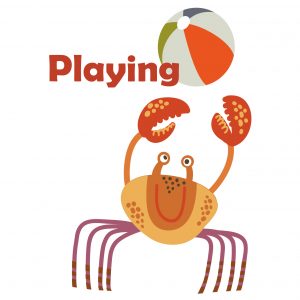Five Skills by Age 6
Build pre-reading skills with these tips and activities.
Jump to:
Talking Together | Singing Together | Reading Together | Writing Together | Playing Together
Talking Together
Talk with your child about what you read together, about the world around them, about everything! Talk about past events and future activities. Use new words to increase vocabulary and ask them questions and listen to their answers.
Easy Ways to Talk to Your Child Today
- Ask questions that cannot be answered with a simple "yes" or "no". This will require your child to practice forming and expressing complete thoughts and to use more vocabulary.
- Repeat what your child says and add more; for example, if your child points out a fire truck, you can say, “Yes, that is a big, red fire truck. It has a siren that makes a loud noise!”
- Narrate your day: talk about making a sandwich while you are doing it, discuss the clothes you dress your child in, talk about the things you see while you walk and drive.
- Make connections with past events. Talk about an activity you and your child did in the past and how that connects to what you are doing now (Example: “Remember when we finished the Cheerios this morning? Now we need to go to the grocery store and buy another box!”).
- Create opportunities to talk together. Take turns telling a story and guessing whether it is true or false.
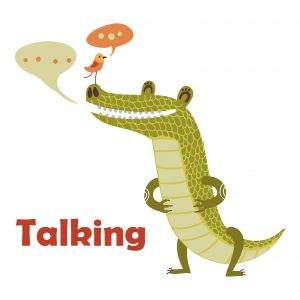
Singing Together
Songs help children learn the rhythms and rhymes of spoken language. Listening to songs helps children learn new words and hear how words are broken up into syllables.
Easy Ways to Incorporate Singing Into Your Day
Anytime of day can turn into a good time to sing. The important thing is that you have fun while your are doing it. Here are some ideas:
- Sing during bath time (Suggestion: "Row, Row, Row Your Boat")
- Sing during meals or snacks
- Sing in the car (Suggestion: "Wheels on the Bus")
- Sing while changing diapers
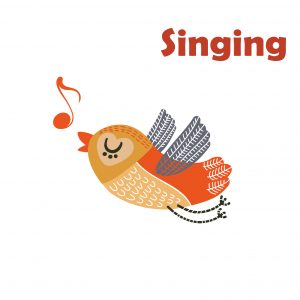
Reading Together
Reading together helps a child develop a love of reading, increases their vocabulary and knowledge of the world, and encourages imaginative thinking.
Easy Ways to Incorporate Reading into Your Day
- Before you begin a new book, look at the front cover and ask your child to predict what the story is about. Leave through the book together and have your child tell you the story based only on the illustrations. Then read the book and discuss what you’ve learned from the story.
As you read, stop and ask your child the five “W” questions. What do you think will happen next? Why? Where is the story taking place? When? Who in the story would you like as a friend? Why? - Show great expressions when you read. Use animated voices for characters. You can even try reading with an accent!
- Introduce your child to different concepts and genres. Also check out audiobooks and listen to it on the drive home. Sit on a terrace and read outside. Check out a nonfiction book and read about something unfamiliar.
- Read before bedtime. Bedtime can be a great time to read with your child because he is calm, comfortable, and can focus on the book with you.
- Keep a few books in the car or diaper bag; if you find yourself waiting in a line somewhere, take advantage of the time and share a book!
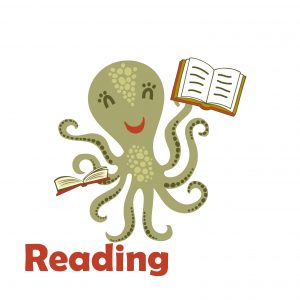
Writing Together
Scribbling and drawing practices hand-eye coordination and develops control of the finger and hand muscles they will need to write. Point out letters and help them understand they represent spoken words.
Easy Ways to Write with Your Child Today
- Let your child doodle by using coloring books, art paper, or even scrap paper. Have your child “sign” his/her name, even if it is just a scribble. Your child’s name is the most important word in her world!
- Point out print all around you: read food labels at the grocery store and at home, talk about road signs or store signs when you are out and about together. All of these conversations help your child understand that written letters stand for the spoken word.
- Put up print in your home. For instance, display your child’s writing on the wall or on the door of his or her room. Let your child scribble on placemats, or create a family message board or chalk board and either practice the alphabet together or explain what you are writing to your child whenever you put up a message.
- Draw different kinds of lines on sheets of paper: straight, zigzag and curved. Have your child practice following each line as they cut with scissors. This develops eye-hand coordination and muscle strength. Both are needed for writing.
- Help your child become an author and illustrator by creating a book together. Fold several pieces of paper and staple the fold. Let your child tell you a story and you’ll write it down. Your child can illustrate each page and then read you the story!
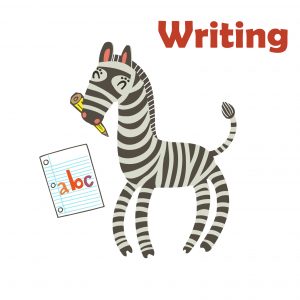
Playing Together
Pretend play helps children learn to think symbolically, develops their narrative language skills, and gives them practice putting thoughts in to words. Children’s natural approach to learning is through play.
Easy Ways to Play with Your Child Today
- Join in when your child plays with his toys. Ask your child what you should do; let them direct the play.
- Keep your old clothes so your children can use them as costumes when they play.
- Head to the park for some great outdoor play!
- Use items you have in the house for dramatic play. Kids love large boxes. Use them to make the mail carrier’s car, a mailbox, a table for your restaurant or a school bus. Grab some envelopes for your post office, use stickers as stamps and practice writing letters. Design your own menu or use take-out menus from a restaurant. Cut out pictures of food from magazines and tape them onto paper plates to serve as food. Be creative and have fun!
- Read interactive stories together such as We’re Going on a Bear Hunt or We’re Going on a Lion Hunt. Use two toilet paper rolls stapled together as binoculars and be overly dramatic as you recite the story and hunt around the house.
